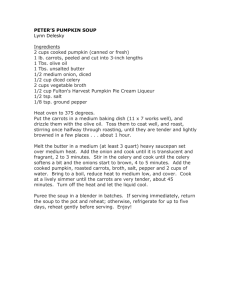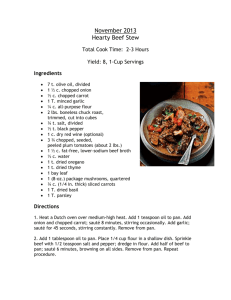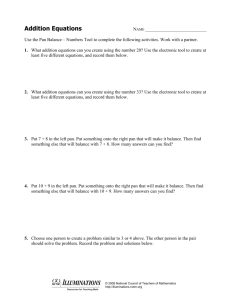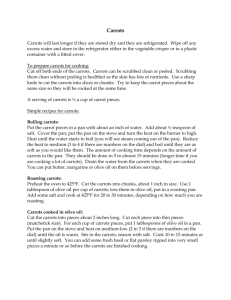Mei Quin Choi - High Ground Organics
advertisement
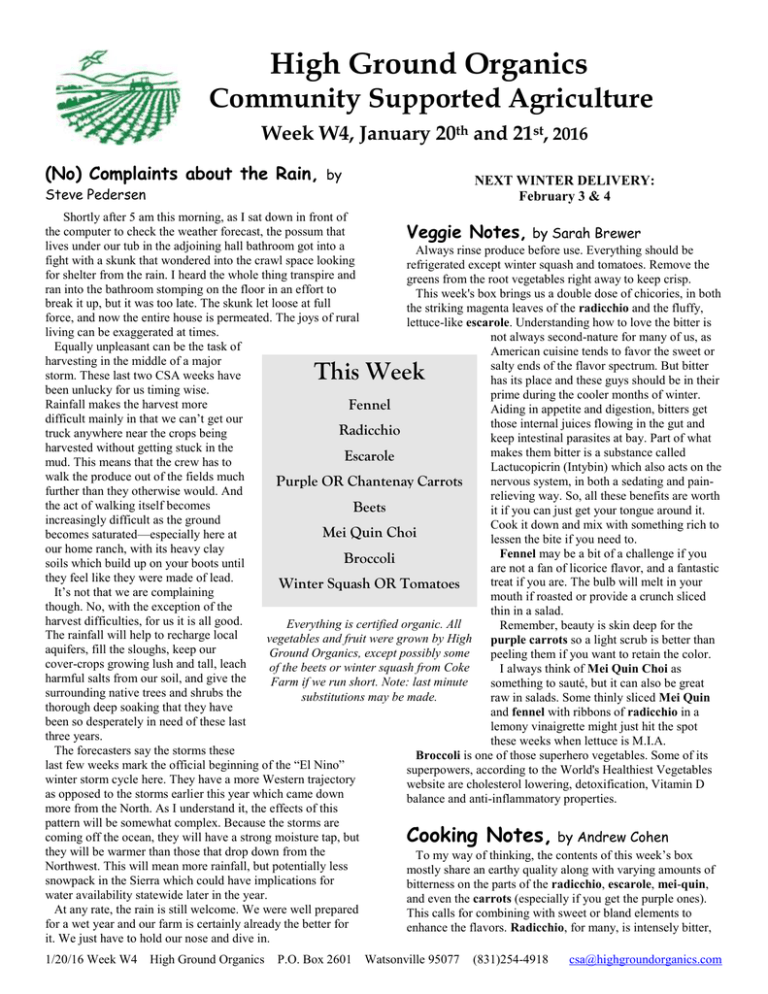
High Ground Organics Community Supported Agriculture Week W4, January 20th and 21st, 2016 (No) Complaints about the Rain, by NEXT WINTER DELIVERY: February 3 & 4 Steve Pedersen Shortly after 5 am this morning, as I sat down in front of the computer to check the weather forecast, the possum that Veggie Notes, by Sarah Brewer lives under our tub in the adjoining hall bathroom got into a Always rinse produce before use. Everything should be fight with a skunk that wondered into the crawl space looking refrigerated except winter squash and tomatoes. Remove the for shelter from the rain. I heard the whole thing transpire and greens from the root vegetables right away to keep crisp. ran into the bathroom stomping on the floor in an effort to This week's box brings us a double dose of chicories, in both break it up, but it was too late. The skunk let loose at full the striking magenta leaves of the radicchio and the fluffy, force, and now the entire house is permeated. The joys of rural lettuce-like escarole. Understanding how to love the bitter is living can be exaggerated at times. not always second-nature for many of us, as Equally unpleasant can be the task of American cuisine tends to favor the sweet or harvesting in the middle of a major salty ends of the flavor spectrum. But bitter storm. These last two CSA weeks have has its place and these guys should be in their been unlucky for us timing wise. prime during the cooler months of winter. Rainfall makes the harvest more Fennel Aiding in appetite and digestion, bitters get difficult mainly in that we can’t get our those internal juices flowing in the gut and Radicchio truck anywhere near the crops being keep intestinal parasites at bay. Part of what harvested without getting stuck in the makes them bitter is a substance called Escarole mud. This means that the crew has to Lactucopicrin (Intybin) which also acts on the walk the produce out of the fields much nervous system, in both a sedating and painPurple OR Chantenay Carrots further than they otherwise would. And relieving way. So, all these benefits are worth the act of walking itself becomes Beets it if you can just get your tongue around it. increasingly difficult as the ground Cook it down and mix with something rich to Mei Quin Choi becomes saturated—especially here at lessen the bite if you need to. our home ranch, with its heavy clay Fennel may be a bit of a challenge if you Broccoli soils which build up on your boots until are not a fan of licorice flavor, and a fantastic they feel like they were made of lead. treat if you are. The bulb will melt in your Winter Squash OR Tomatoes It’s not that we are complaining mouth if roasted or provide a crunch sliced though. No, with the exception of the thin in a salad. harvest difficulties, for us it is all good. Everything is certified organic. All Remember, beauty is skin deep for the The rainfall will help to recharge local vegetables and fruit were grown by High purple carrots so a light scrub is better than aquifers, fill the sloughs, keep our Ground Organics, except possibly some peeling them if you want to retain the color. cover-crops growing lush and tall, leach of the beets or winter squash from Coke I always think of Mei Quin Choi as harmful salts from our soil, and give the Farm if we run short. Note: last minute something to sauté, but it can also be great surrounding native trees and shrubs the substitutions may be made. raw in salads. Some thinly sliced Mei Quin thorough deep soaking that they have and fennel with ribbons of radicchio in a been so desperately in need of these last lemony vinaigrette might just hit the spot three years. these weeks when lettuce is M.I.A. The forecasters say the storms these Broccoli is one of those superhero vegetables. Some of its last few weeks mark the official beginning of the “El Nino” superpowers, according to the World's Healthiest Vegetables winter storm cycle here. They have a more Western trajectory website are cholesterol lowering, detoxification, Vitamin D as opposed to the storms earlier this year which came down balance and anti-inflammatory properties. more from the North. As I understand it, the effects of this pattern will be somewhat complex. Because the storms are coming off the ocean, they will have a strong moisture tap, but by Andrew Cohen they will be warmer than those that drop down from the To my way of thinking, the contents of this week’s box Northwest. This will mean more rainfall, but potentially less mostly share an earthy quality along with varying amounts of snowpack in the Sierra which could have implications for bitterness on the parts of the radicchio, escarole, mei-quin, water availability statewide later in the year. and even the carrots (especially if you get the purple ones). At any rate, the rain is still welcome. We were well prepared This calls for combining with sweet or bland elements to for a wet year and our farm is certainly already the better for enhance the flavors. Radicchio, for many, is intensely bitter, it. We just have to hold our nose and dive in. This Week Cooking Notes, 1/20/16 Week W4 High Ground Organics P.O. Box 2601 Watsonville 95077 (831)254-4918 csa@highgroundorganics.com so pairing with onions, fennel, and carrots works well, as does sautéing with balsamic vinegar or fig reduction. Bacon is also an excellent mitigant to radicchio’s bite. Escarole is milder, with the paler leaves being more tender and less sharp. The palest softest center leaves work in salads, while the whole head is excellent for sautéing. Fennel or carrot pair well in this case-see the recipe for carrots and escarole and use fennel instead of carrots. For mei-quin, a friend told me she uses it instead of celery sticks with peanut butter. This sounds great to me, and triggered the idea of a quick sauté of mei-quin with onion and carrot threads in a little coconut milk, ginger, and stock, and then drizzled with peanut sauce (see recipe for Bon-Bon sauce on site, skip the chili, lighten up a little on the sesame oil, and thin with a little water or coconut milk). Serve with jasmine rice or noodles. Thinking of nutty flavors, roast beets cut into chunks and sautéed with a touch of garlic and served with lots of crunchy chopped roasted almonds and/or pistachios makes a nice side dish right now. You could serve it alongside a braise of cubed pork shoulder or butt cooked with seared fennel wedges, olives, chunked carrots, onion, and fennel seed all cooked in Rioja wine. If you are looking for a hearty meat free dish that will feel like meat, cook up the roasted Portobellos with radicchio farro. The fennel pesto that accompanies the Roasted Carrots with Fennel Jam is quite versatile, and would serve well with chicken, fish, pork, pasta, grains, (deep breath in) and as a smear on sandwiches. Not to mention as a garnish for vegetables and soups. If desserts that blur the sweet/savory line tickle your taste buds, try a tarte with caramelized fennel and carrot with candied fennel seeds. If you want to go all out Italian, make the base with polenta. Do the entire recipe in a cast iron pan to produce a veg-centric dessert à la Tarte Tatin. Note: We can’t print them all, but Chef Andrew’s recipes are always available in full at highgroundorganics.com. Caramelized Carrots and Melted Escarole, from Chef Andrew E Cohen 1 bunch escarole, chopped and washed, leaving some water remaining on the leaves 1 tablespoon sugar, or less Olive oil as needed Salt and pepper to taste 1 bunch carrots, cut into ¼ inch cubes ½ tablespoon butter ½ tsp. fresh thyme, chopped Water as needed Heat a 2 quart chef’s pan or 10 inch sauté pan over medium heat. When hot, sprinkle enough sugar on the pan bottom to just cover it. Cook until the sugar melts and is turning golden. Wait just until it starts to smell caramelized, then add the butter, thyme, and a little oil. Pick up the pan and swirl it to melt the pan and allow the pan to cool a little. Add the carrots and toss to coat with the caramel, then add enough water to cover the carrots by 1 inch. Bring to a simmer and cook the carrots until just tender all the way through. Use a slotted spoon to remove the carrots to a bowl and keep warm. Simmer the cooking liquid until reduced to ½ cup. Set pan aside. As the carrots cook, heat a 10-inch sauté pan over mediumhigh heat. Lightly film the pan with oil. When hot, add the carrots, tossing to coat with oil. Sauté to heat through and add color to the cubes, crisping them a little. Add the escarole to the pan and season with salt and pepper. (If there is too much escarole to fit the pan without it falling out, add half, then when it wilts down, add the rest.) Toss to mix the carrots with 1/20/16 Week W4 High Ground Organics the escarole and to get the escarole to the pan bottom. Cook until wilted, then add the remaining carrot cooking liquid, drizzling it all over. Toss the pan contents to coat with the liquid and cook until it reduces to a syrup. Serve hot. Serves: 4 Roasted Portobello Chunks with Farro Radicchio Sauté, from Chef Andrew E Cohen This is a dish with some substance, and the mushrooms make a good substitute for meat texturally and flavor-wise. 3-4 medium Portobello mushrooms, with pale gills and a lip that curls under somewhat, cut into 1-inch chunks 1 small yellow or white onion cut into 3/16ths inch dice 3 cups cooked farro ½ cup olive oil + more as needed ¼ TBS fresh marjoram, minced, or the needles from a 1-inch piece of rosemary, minced 3 cloves garlic, peeled, degermed, minced Water if needed 2 medium to small heads radicchio, trimmed and cut into ¼ inch ribbons 2-3 carrots, peeled and cut as above (1½ cups) ¾ cup red wine vinegar ½ cup balsamic vinegar ½ TBS + 1 tsp. fresh thyme, minced Salt and pepper to taste In a non-reactive bowl, whisk together the vinegars, the ½ tablespoon thyme, marjoram or rosemary, some pepper, and 2/3rds of the garlic. Whisk in the ½ cup of oil, and then add the mushroom chunks, tossing to coat well. If a lot of the mushrooms are above the level of the marinade, add a little water so the marinade will cover the mushrooms. Allow to marinate for 1-3 hours. Heat the oven to 425°F. Heart a medium sauté pan over medium heat. When hot, film well with oil and add the carrots, onions, and teaspoon of thyme. Sauté until the onions are softened and starting to caramelize and the carrots are turning golden. Add the farro, adding oil to the mix just to coat the farro so it does not stick, and sauté until good and hot. While the vegetables cook, drain the mushrooms, saving the marinade, and place on a foil lined sheet pan and place into the center of the oven. Cook for 12-15 minutes until they are cooked through-tender all the way through and starting to crisp on the edges. When done, remove from the oven and keep hot. While the mushrooms cook, remove the farro and vegetables to a bowl, keep warm, and return the pan to the heat. Add a touch of oil and add the garlic. Cook until fragrant and softening a little. Add a tablespoon of the marinade to the pan and heat up. Add the radicchio to the pan and toss to coat. Cook until the radicchio wilts and becomes tender. Add more marinade and cook until it reduces to a syrup and coats the radicchio. Add back the farro and vegetables and toss to combine well. Heat through. The mushrooms should be done at this point. If there is any liquid from the mushrooms on the sheet pan, you can pour it into the farro and toss to distribute it. Put the farro onto a platter or plates, then top with the mushrooms. Serve hot. Serves: 4 P.O. Box 2601 Watsonville 95077 (831)254-4918 csa@highgroundorganics.com

